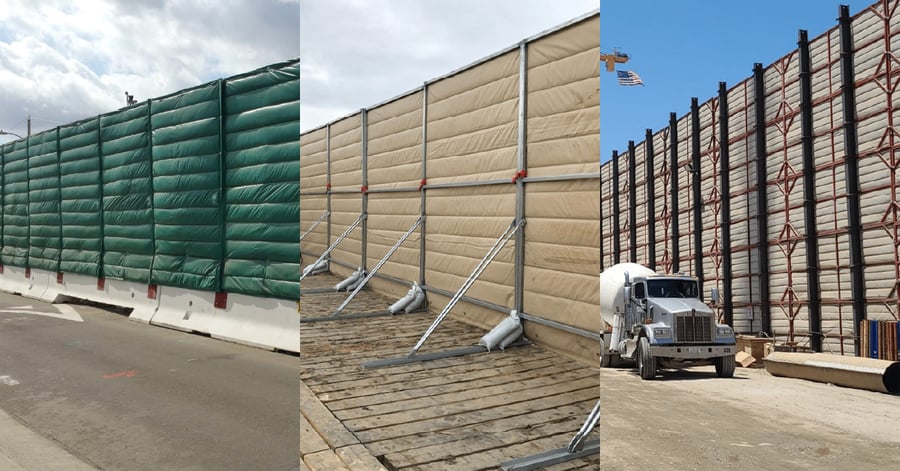
How To Choose the Right Noise Barriers for Your Project
Matt R. Cott
Whether you're managing a construction site, data center, or pipeline project, noise control isn't just about being a good neighbor — it's about compliance, safety, and project success.
But with several noise barrier options on the market, each claiming to be the ultimate solution, how do you choose the right one for your specific needs? The answer lies in understanding that effective noise control isn't one-size-fits-all. It requires careful consideration of your unique project requirements, from the type of noise you're generating to the specific regulations governing your site.
This guide breaks down the essential factors you need to consider when selecting noise barriers, helping you make informed decisions that protect your budget, timeline, and reputation.
1. Understand The Noise You’re Trying To Mitigate
The type of noise barrier you need depends on the type of noise your project is producing. While the volume of sound is important, its frequency is even more so.
The #1 mistake project managers make is choosing noise barriers that are not designed for the frequency of noise their project is producing. At a high level, this is what you need to consider:- Low-frequency sounds — like diesel engines, compressors, or pumps — have long wavelengths and are incredibly difficult to mitigate. They typically need to be blocked with mass and density.
- High-frequency sounds — like saws, alarms, or hammering — have short wavelengths and are much easier to mitigate with relatively thin materials.
- What’s generating the noise?
- What’s the frequency range?
To accurately answer the second question, you’ll likely need the help of a professional acoustic company. They can perform detailed assessments using tools like decibel meters and acoustic modeling software to determine the ideal materials and layout for your barriers.
Pro tip: Include acoustic assessments early in project planning to avoid costly retrofits or compliance violations later on.
2. Assess Your Project Timeline
Your project’s timeline and mobility requirements heavily influence the right solution:- Short-term projects require barriers that are quick to deploy, weather-resistant, and easy to relocate.
- Mid to long-term projects benefit from semi-permanent structures that offer improved durability and greater acoustic control.
- Permanent facilities often require custom-engineered systems that become part of the site design.
- Modular panel systems that connect with minimal tools and equipment
- Built-in forklift pockets or rigging points for safe handling
- Lightweight materials that meet performance specs without adding transport headaches
3. Account for Site-Specific Constraints
Your site’s physical environment can help or hinder your noise control strategy. Every location brings unique challenges:- Obstacles like power lines, trees, or cranes may limit how tall your barrier can be or dictate how close it can be placed to the noise source.
- Terrain and elevation changes can affect sound direction, potentially creating acoustic “hot spots” where noise is amplified.
- Weather patterns — especially wind — can impact not only how sound travels but also how secure your barrier needs to be.
- Visibility in urban areas and even high-traffic roadsides may justify a custom wrap that makes noise barriers more visually appealing.

4. Check Noise Ordinances
Noise regulations vary at the local, state, and federal levels. They also depend on your industry and specific job site. For example, if you’re operating by a hospital, school, or residential area, you’ll need to meet stricter rules. Ignoring them can result in fines, bad press, and stop-work orders. Many jurisdictions enforce:- Day vs. night decibel thresholds
- Limits on impulse or tonal noise
- Permit conditions that mandate noise mitigation equipment
- STC (Sound Transmission Class): Indicates how well a material blocks sound.
- NRC (Noise Reduction Coefficient): Indicates how well a material absorbs sound.
5. Work With a Noise Mitigation Specialist
Choosing noise barriers is probably not at the top of your job description (or list of favorite activities). The best way to ensure you choose the right solution is to partner with a full service acoustic company like Environmental Noise Control.
They handle everything from initial noise assessments and frequency analysis to custom barrier design and professional installation. Their comprehensive approach ensures you get barriers perfectly matched to your noise profile, project timeline, site constraints, and regulatory requirements.
Cost is always a factor — but the cheapest solution upfront may cost more later. Paying once for quality is always better than paying twice to replace a cheap solution that didn’t work.

